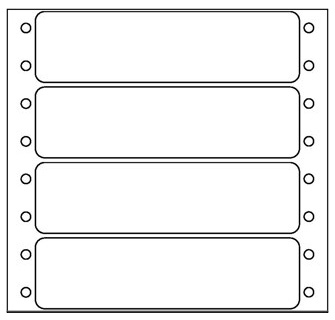Understanding Just How Blank Labels Work to Boost Your Labeling Experience
Recognizing the auto mechanics of blank labels is crucial for optimizing your labeling practices across numerous contexts. These functional tools supply considerable advantages, such as personalization and adaptability, making them a suitable option for both specialist settings and individual usage. From inventory administration to home company, the implications of their strategic application can bring about enhanced effectiveness. To totally grasp exactly how these labels can change your processes, one have to consider the different kinds readily available and the myriad means they can be customized to suit certain demands.

Benefits of Using Blank Labels
Blank labels use a flexible service for various identifying needs, making them very useful in both individual and professional setups. Their adaptability enables customers to produce customized labels tailored to details demands, boosting business efficiency. Whether used in office, retail environments, or commercial applications, blank labels facilitate the identification and classification of products, files, and individual things.
One substantial advantage of blank labels is their cost-effectiveness. By allowing users to print only the labels they require, waste is lessened, and supply management ends up being extra manageable. Additionally, blank labels are compatible with different printing techniques, consisting of inkjet and printer, making them accessible for different users.

Moreover, using blank labels streamlines the process of upgrading information, as individuals can conveniently print new labels to change out-of-date ones, making certain that all products and papers are properly labeled. Generally, blank labels provide a useful and reliable labeling solution for diverse applications.
Kinds of Blank Labels Available
What options are readily available when it pertains to blank labels? Blank labels come in a range of kinds, each suited for different applications and choices. One of the most usual types consist of paper labels, which are functional and affordable, making them suitable for day-to-day usage. They are available in various surfaces, such as matte and shiny, permitting for visual adaptability.
One more prominent choice is synthetic labels, commonly made from products like polyester or vinyl. These labels are known for their toughness and resistance to water, chemicals, and tearing, making them ideal for extreme settings. They are generally made use of in commercial setups or for labeling items that might be subjected to wetness.
In addition, there are thermal transfer labels, which call for a printer that makes use of warmth to move ink onto the label surface. These labels are favored for their top quality print and longevity.
Lastly, specialized labels satisfy details demands, such as imp source detachable labels for short-lived use or high-temperature labels for extreme problems. Recognizing these options allows users to select the most appropriate blank tag for their one-of-a-kind labeling needs.
Personalization Options for Labels
A broad range of customization options is available for labels, allowing customers to customize them to particular demands and branding needs. Individuals can select from numerous sizes, forms, and materials to ensure that the labels properly fit their desired function. Common products include paper, polyester, and plastic, each providing different degrees of sturdiness and aesthetic charm.
Color options play a crucial duty in personalization, enabling brands to keep consistency with their company identity. Customers can select from a range of shades or perhaps decide for customized printing to match details branding aspects. In addition, labels can be printed with special designs, logos, and message, enhancing brand name acknowledgment and visual influence.
Another crucial aspect is the option of adhesive. Tags can be designed with long-term, detachable, or repositionable adhesives, depending on the application demands. This adaptability enables effective labeling options across different settings, from retail to industrial settings.

Tips for Effective Labeling
Reliable labeling goes past customization; it additionally includes strategic factors to consider that enhance capability and communication. To attain effective labeling, start by clearly defining the objective of each label.
Next, focus on exposure by picking proper colors and font styles. High comparison between message and history enhances readability, while bigger fonts assist in fast identification. In addition, ensure that labels are placed in a regular and logical way, making it easier for individuals to find and analyze information.
Take into consideration the resilience of labels too. Pick materials fit for the certain environment where the labels will be made use of, whether it be indoors or outdoors. Water resistant or tear-resistant choices might be necessary depending upon the context.
Finally, regularly review and update your labels to show any kind of adjustments in information or use. This proactive method not just keeps quality yet also avoids confusion in time. By complying with these ideas, you can maximize the performance of your labeling efforts, guaranteeing they offer their intended purpose effectively.
Applications of Blank Labels
Blank labels offer various applications across various industries, making them an important tool for company and interaction. These functional labels are commonly made use of in storehouses for stock administration, enabling companies to quickly determine and track products. By applying blank labels to storage space containers, racks, or pallets, business can streamline their operations and lower the chance of mistakes.
In the health care sector, blank labels play a critical role in classifying medicines and medical products, making certain appropriate identification and use. Adjustable labels can include essential details such as dosage, expiration dates, check my source and person information, enhancing safety and security and conformity.
In retail, blank labels assist in rates products, providing promos, or identifying rack places, which inevitably enhances the customer experience. They enable quick updates to pricing or item this website information without the requirement for pre-printed labels.
Additionally, blank labels are beneficial for individual use, such as arranging office, crafting, or identifying food containers. Their flexibility enables individuals to produce customized options that meet certain needs. Generally, the applications of blank labels are comprehensive, emphasizing their significance in fostering effectiveness and clarity in different setups.
Conclusion
In final thought, blank labels offer a versatile and effective remedy for different classifying demands. Inevitably, the integration of blank labels into operational processes contributes to improved effectiveness, making them an indispensable source for both individual and professional use.